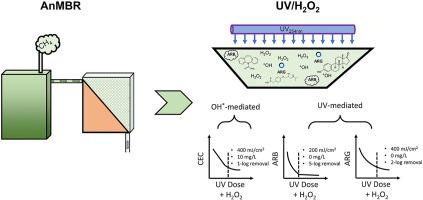Environmental Research ( IF 8.3 ) Pub Date : 2020-11-16 , DOI: 10.1016/j.envres.2020.110479 Nicolas Augsburger , Noor Zaouri , Hong Cheng , Pei-Ying Hong

|
Effluent from anaerobic membrane bioreactor (AnMBR) contains ammonia and would require post-polishing treatment before it can be disinfected by chlorine. However, additional post-treatment steps to remove nutrients offset the energetic benefits derived from anaerobic fermentation. The use of chlorine or ozone also promotes concerns associated with disinfection byproducts. This study evaluates UV/H2O2 as a potential strategy suited for the removal of pharmaceutical compounds as well as antibiotic resistant bacteria (ARB) and antibiotic resistance genes (ARGs) from AnMBR effluent. Our findings indicate that 10 mg/L H2O2 and 61.5 mJ/cm2 of UV fluence are able to achieve a 4-log removal of both Escherichia coli PI7 and Klebsiella pneumoniae L7. However, a higher fluence of 311 mJ/cm2 with the same amount of H2O2 would be required to achieve > 90% removal of atenolol, carbamazepine and estrone. The removal of the pharmaceutical compounds was driven by the hydroxyl radicals generated from H2O2, while UV exposure governed the inactivation of ARB and ARGs. UV/H2O2 increased overall mutagenicity of the treated wastewater matrix but did not result in any changes to the natural transformation rates. Instead, UV significantly reduced natural transformation rates by means of DNA damage. Overall, UV/H2O2 could be the ideal final disinfection strategy for AnMBR effluent without requiring additional post-treatment prior disinfection.
中文翻译:

使用UV / H 2 O 2促进厌氧膜生物反应器流出物中新兴污染物的去除
厌氧膜生物反应器(AnMBR)的流出物中含有氨,在对其进行氯消毒之前,需要进行后抛光处理。但是,去除营养的其他后处理步骤抵消了厌氧发酵产生的能量益处。氯气或臭氧的使用也引起与消毒副产物有关的担忧。这项研究评估了UV / H 2 O 2作为适合于从AnMBR废水中去除药物化合物以及抗生素抗性细菌(ARB)和抗生素抗性基因(ARG)的潜在策略。我们的发现表明,10 mg / LH 2 O 2和61.5 mJ / cm 2的紫外线通量能够实现两者的4-log去除大肠杆菌PI7和肺炎克雷伯菌L7。但是,要获得> 90%的阿替洛尔,卡马西平和雌酮去除率,在相同量的H 2 O 2下需要更高的通量(311 mJ / cm 2)。H 2 O 2产生的羟基自由基驱使药物化合物的去除,而紫外线暴露则控制了ARB和ARG的失活。UV / H 2 O 2提高了处理后的废水基质的总体诱变性,但未导致自然转化率发生任何变化。相反,紫外线通过DNA破坏显着降低了自然转化率。总体而言,UV / H 2O 2可能是AnMBR废水的理想最终消毒策略,而无需在消毒前进行额外的后处理。



























 京公网安备 11010802027423号
京公网安备 11010802027423号